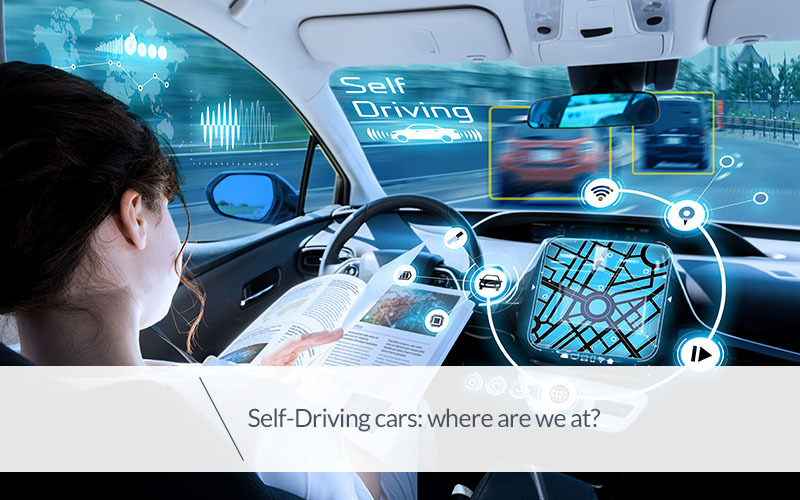
Autonomous cars are fast becoming one of the most revolutionary innovations in mobility, promising to change the way we get around radically.
As technologies continue to develop, vehicles capable of moving without human intervention now seem to be getting closer and closer to becoming an everyday reality.
In this article, we will explore how these vehicles work, the technologies that make them possible, the regulatory and non-regulatory implications for safety and efficiency, and the ethical and engineering challenges we still face.
What is an autonomous car?
An autonomous car is a vehicle that uses advanced technology to navigate the road and operate without the driver, allowing the vehicle to move partially or fully autonomously via safety and control systems.
These vehicles employ a combination of sensors, cameras, radar and artificial intelligence (AI) to monitor their surroundings and move between different locations without the need for human intervention, operating on any type of road. The Society of Automotive Engineers (SAE) has defined six levels of automation:
- SAE 0 - total manual driving with no automated assistance.
- SAE 1 - driver assistance systems, such as lane departure warning.
- SAE 2 - partial automation, with the driver having to maintain control.
- SAE 3 - conditional automation, operating in specific scenarios, such as motorways.
- SAE 4 - high automation requiring no human intervention in most situations.
- SAE 5 - full automation that eliminates the need for the driver.
In Italy, vehicle registration is currently only allowed for vehicles up to SAE level 2, according to the Decree of 28 February 2018, which regulates the testing of self-driving vehicles.
Furthermore, it is important to note that the SAE uses the term ‘automated’ instead of ‘autonomous’ to distinguish different degrees of automation: a fully autonomous car can make decisions independently, while an automated car executes commands and drives autonomously.
Thus, although the term ‘self-driving’ is often used as a synonym for ‘autonomous’, technically it refers to vehicles that can drive autonomously in specific situations (SAE levels 3 or SAE 4), but still require the presence of a driver ready to intervene.
SAE level 5 vehicles, on the other hand, are fully autonomous, with no steering wheel or pedals, and can operate in any context without any human intervention.
How do autonomous cars work?
Autonomous vehicles use a combination of advanced technologies to monitor their surroundings and make decisions in real time. Among the main technologies used are:
- LiDAR (Light Detection and Ranging): uses laser pulses to create detailed 3D maps of the environment.
- Radar: detects objects over long distances, even in poor visibility conditions such as fog or rain.
- Cameras: provide high-resolution images for recognising traffic signs, pedestrians and other vehicles.
- AI and Machine Learning: process data collected by sensors to make autonomous decisions in real time.
- V2X Communication: enables vehicles to communicate with other cars and road infrastructure, improving safety.
Autonomous vehicles create a map of their surroundings using a variety of sensors. Radar monitors the position of nearby vehicles, cameras detect road signs and pedestrians, and LiDAR sensors measure distances and identify road limits.
This data is processed by advanced algorithms that generate acceleration, braking and steering decisions.
Implications of autonomous driving
The introduction of autonomous cars could totally revolutionise mobility. In addition to widening the accessibility of driving, offering new opportunities to those previously unable to drive, these technologies could also improve the quality of life for those who spend extensive hours behind the wheel: users could focus their attention on other activities during the journey.
The benefits include a significant improvement in road safety, due to a reduction in human error, and greater energy efficiency, with better optimised traffic management. Nevertheless, for autonomous driving to become an accessible reality on a large scale, it will be necessary to develop affordable technological solutions that can also include those who cannot afford a technological car today.
However, this change does not come without challenges, such as regulatory, ethical and engineering issues. Laws need to be updated, moral dilemmas related to the decisions autonomous vehicles might have to make need to be addressed, and high standards of security, both cyber and technological, need to be ensured.
Ethical and engineering research
Research is currently proceeding on two main fronts: ethical and engineering.
- On the one hand, it is crucial to establish ethical guidelines to deal with extreme situations, such as unavoidable accidents.
- On the other hand, work is being done to develop algorithms that can prevent accidents and reduce risks.
An interesting example is MIT's ‘The Moral Machine’ project, which collected over 39 million decisions from 233 countries. This study explores how autonomous cars might deal with unavoidable accident situations and highlights cultural differences in ethical choices, with some companies prioritising saving the most people, while others prioritise the elderly or those who obey traffic laws.
Another example is the ‘train track dilemma’, an ethical and moral problem introduced in 1964 by the British philosopher Philippa Ruth Foot and now applicable to autonomous cars.
Indeed, the design of autonomous cars raises important ethical dilemmas in the handling of critical situations. Although the ethical guidelines (contained in the document Rome Call for A.I. Ethics by the Pontifical Academy for Life together with FAO, IBM, Microsoft and the Italian Ministry of Innovation) suggest that human life should prevail over that of animals and that there should be no discrimination according to age or gender, it is ‘The Moral Machine’ itself that shows us how moral preferences vary widely according to culture.
These dilemmas highlight the difficulties in implementing ethical choices in machines, as artificial intelligence, while excelling in stable environments, struggles to handle unpredictable and complex situations, such as those in traffic. Therefore, it is essential to develop an ethics of AI that protects human dignity, considering different cultural sensitivities and technical challenges.
On the engineering side, research focuses on improving safety. One example is the algorithm developed by the University of Munich, which calculates the specific risk for each road user, combining the probability of collision with the potential damage to select the least risky trajectory.
Research and experiment projects
In the United States, a collaborative research project between DriveOhio, the Department of Transportation, and Ohio University recently concluded a four-year study on the feasibility of autonomous vehicles in rural areas. The “Rural Automated Driving Systems” (ADS) project explored the challenges and opportunities these vehicles face in less populated settings, such as southeast Ohio.
Led by Jay Wilhelm, the project involved students in the fields of mechanical and computer engineering to evaluate how autonomous vehicles adapt to complex infrastructures and brought solutions to complex problems, including loss of GPS signal and difficulty in detecting road signs.
Also in Italy, experiments on autonomous driving are underway thanks to the collaboration between A2A, MOST and PoliMi (Milan Polytechnic), which has resulted in the first autonomous car sharing in the city of Brescia in recent months. Here, an electric Fiat 500, equipped with an autonomous driving system, can reach the customer, take them to their destination and return autonomously to the wireless charging station. A cutting-edge initiative that aims to reduce traffic congestion and promote sustainable mobility in cities.
The hacker danger in autonomous cars
One of the main fears related to the spread of self-driving cars is the vulnerability to cyber-attacks. Cybercrime could exploit any flaws in security systems to take control of vehicles for blackmail or sabotage.
Although such a scenario cannot be dismissed out of hand, hacking an autonomous car requires the complex penetration of an integrated network of sensors and communications. Manufacturers are investing considerable resources to protect their systems through advanced encryption, real-time monitoring and continuous software updates, to prevent intrusions and ensure passenger safety.
The regulatory framework
In the United States, several states have started to regulate the use of autonomous cars. For example, Kentucky has introduced a law establishing regulations for these vehicles, including commercial trucks, starting for 2026. The law requires owners to submit safety plans and obtain specific insurance, which is significantly higher than that required for traditional vehicles.
Starting from 1 March 2025, Switzerland will be the first European country to allow self-driving cars on certain roads. Initially, vehicles with ‘advanced level 3’ of automation will be allowed. From July 2025, knowledge about self-driving vehicles will become an integral part of the driving test for Swiss drivers.
Regarding the countries belonging to the European Union, a significant step was taken in June 2022 with the adoption of Regulation (EU) 2022/2236. This regulation sets out technical requirements for various vehicle categories, including those produced in unlimited and small series, special purpose vehicles, and fully automated vehicles.
Most notably, it opens the door to the type approval of fully automated vehicles produced in small series — even those without a seat for a human driver. For the first time, the regulation introduces adapted technical requirements not only for automated driving systems, but also for other critical systems such as passive safety, emissions, and general safety.
Three architectures of automated vehicles are covered:
- Dual-mode vehicles: combining manual and fully automated driving modes
- Fully automated vehicles (N1, N2, N3, M1, M2, M3): without a driver seat, with occupants
- Fully automated goods vehicles (N1, N2, N3): without a driver seat and without occupants
The autonomous car market
There are many players in the development of driverless cars: major OEMs and Tier 1s include Mercedes-Benz, General Motors, Continental Automotive Systems, Autoliv Inc., Bosch, Nissan, Toyota, Audi and Uber, the latter being particularly interested in reducing driver-related costs. Tesla continues to be a key player in the autonomous driving landscape, while Apple recently scaled back funding for its Titan project. BYD, on the other hand, has made considerable progress with its ‘God's Eye’ system, focusing on advanced and affordable technology.
A significant innovation is the Nvidia Cosmos platform, unveiled at CES in Las Vegas, which enables the creation of complex virtual environments to train artificial intelligence, thus accelerating the development and improvement of autonomous vehicle safety.
Autonomous cars: present and future
The future of autonomous cars presents exciting but also complex challenges, mainly related to technological advances, social resistance and the need for a new regulatory framework.
Although autonomous vehicles are already making significant strides, such as in the improvement of sensors and artificial intelligence, further developments will be needed to achieve full automation (SAE level 5), especially regarding the ability to operate in all weather conditions and improved interactions with, in many cases future, smart urban infrastructure.
However, the adoption of this technology is encountering many cultural and social difficulties today, with motorists expressing scepticism towards the idea of not being in direct control of the vehicle, as in the case of a survey of Americans showing that as many as 6 out of 10 drivers would be afraid of being in a fully autonomous vehicle; truck drivers fearing the loss of their jobs and driving enthusiasts not wishing to leave the wheel.
In parallel, legal and regulatory standards will have to be updated to address issues such as liability in the event of an accident and the protection of privacy, so as to strike a new and delicate balance between innovation, safety and ethics.
To sum up, the evolution of autonomous vehicles has the potential to radically transform the transport landscape, paving the way for new markets and shared mobility platforms. Nevertheless, the path to mass adoption is challenging and complex to date and includes significant technological and societal adaptation.
Soon, self-driving cars could become a fundamental part of our daily lives, revolutionising the way we move around and interact with our surroundings.



